The Influence of Youtubers on Consumers' Purchase Intention in Vietnam
VerifiedAdded on 2021/08/12
|30
|8691
|84
Report
AI Summary
This report, submitted to the business department, examines the influence of Youtubers on consumers' purchase intentions, specifically focusing on the Hoa Cuong Nam ward in Da Nang city, Vietnam. The research employs a quantitative methodology, collecting data from 208 respondents through an online questionnaire. The study investigates the impact of factors such as perceived usefulness of information, attractiveness of videos, the number of views, likes, comments, and replies, and the trustworthiness of Youtubers on consumers' buying intentions. The report includes a literature review, detailed methodology, data analysis using descriptive and inferential statistics, and a regression model. The findings discuss the relationship between Youtubers and consumer behavior, offering insights into online marketing strategies and consumer decision-making processes in the digital age. The research also acknowledges limitations and suggests directions for future studies.
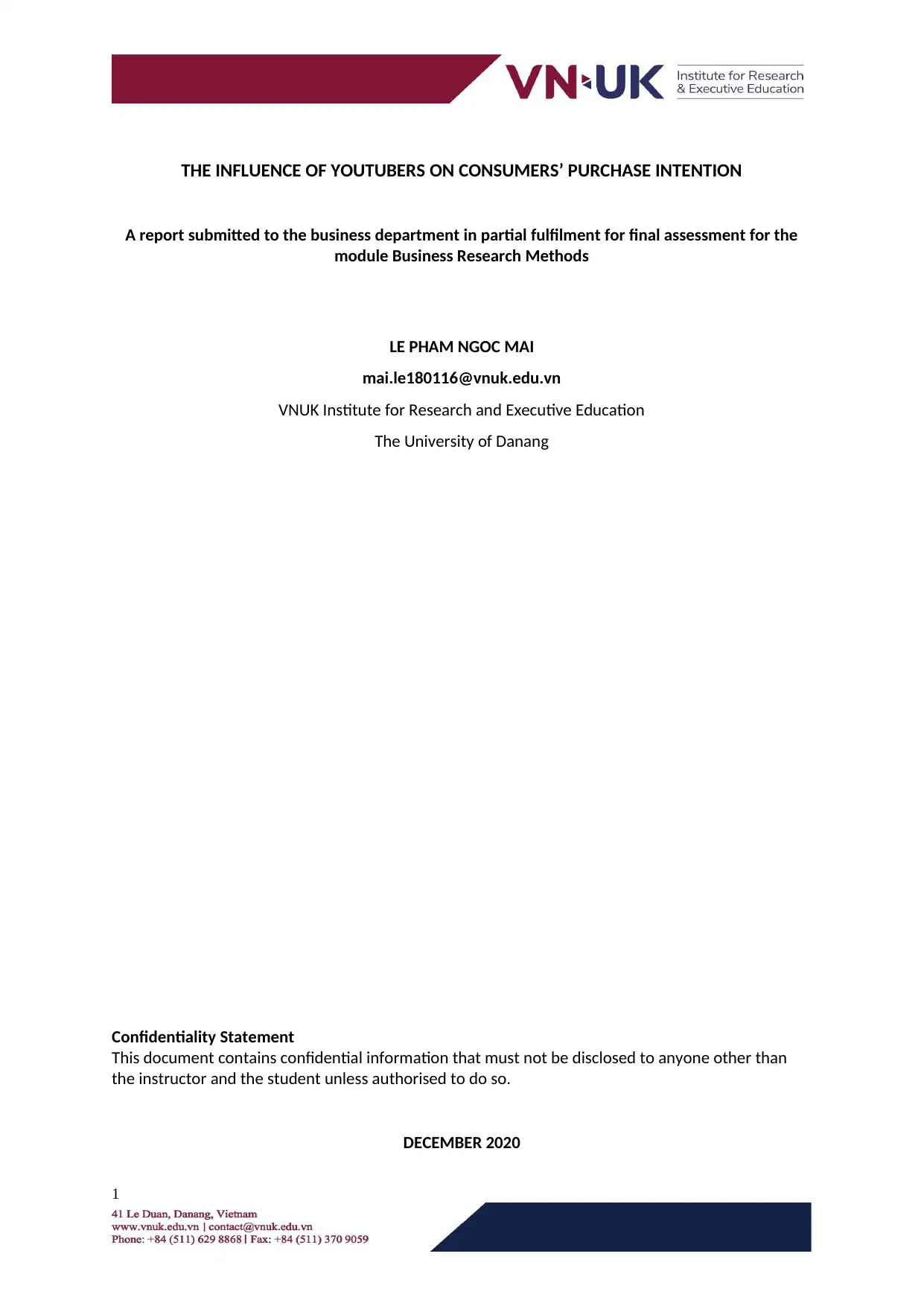
THE INFLUENCE OF YOUTUBERS ON CONSUMERS’ PURCHASE INTENTION
A report submitted to the business department in partial fulfilment for final assessment for the
module Business Research Methods
Confidentiality Statement
This document contains confidential information that must not be disclosed to anyone other than
the instructor and the student unless authorised to do so.
DECEMBER 2020
1
LE PHAM NGOC MAI
mai.le180116@vnuk.edu.vn
VNUK Institute for Research and Executive Education
The University of Danang
A report submitted to the business department in partial fulfilment for final assessment for the
module Business Research Methods
Confidentiality Statement
This document contains confidential information that must not be disclosed to anyone other than
the instructor and the student unless authorised to do so.
DECEMBER 2020
1
LE PHAM NGOC MAI
mai.le180116@vnuk.edu.vn
VNUK Institute for Research and Executive Education
The University of Danang
Paraphrase This Document
Need a fresh take? Get an instant paraphrase of this document with our AI Paraphraser
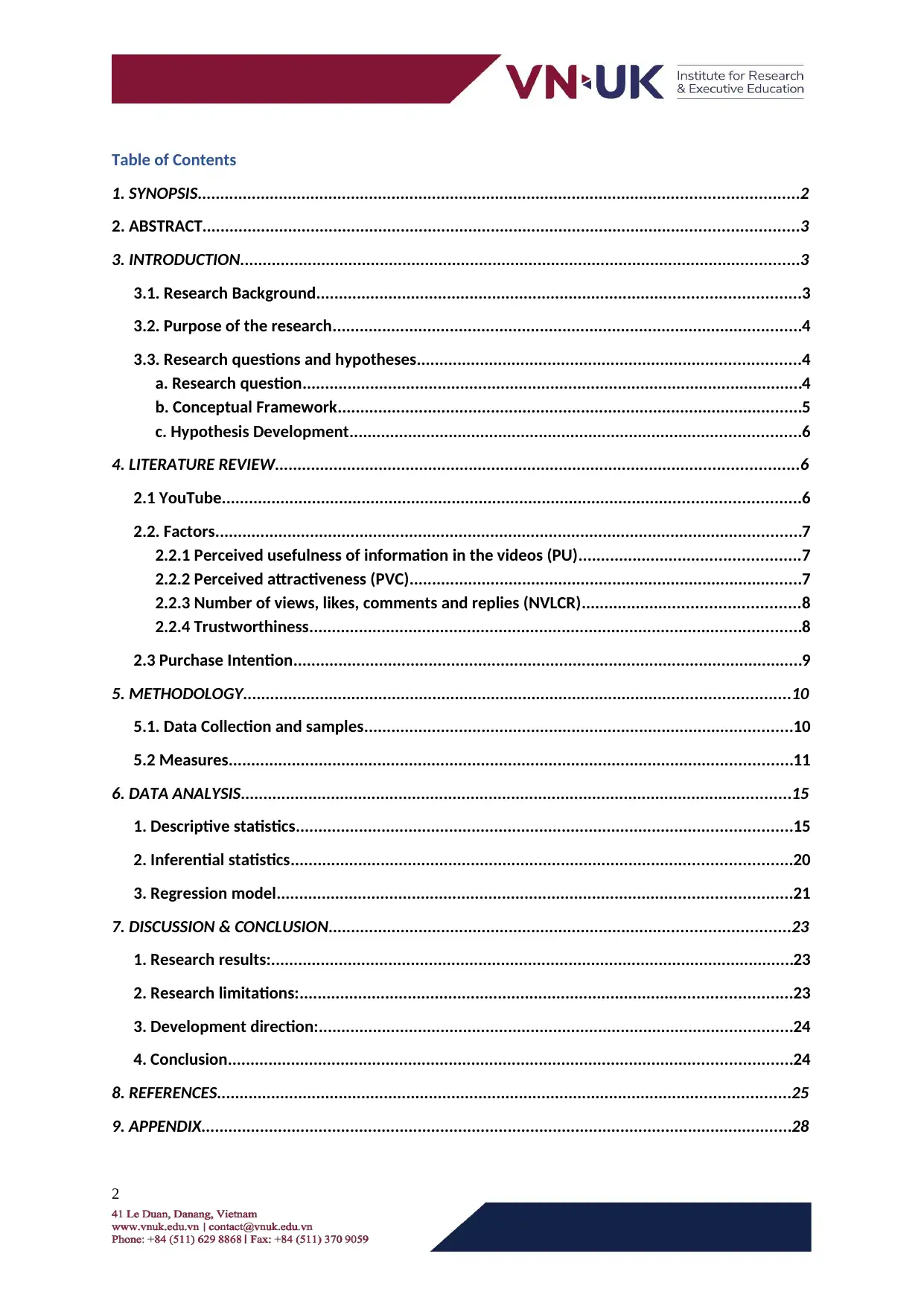
Table of Contents
1. SYNOPSIS.....................................................................................................................................2
2. ABSTRACT....................................................................................................................................3
3. INTRODUCTION............................................................................................................................3
3.1. Research Background...........................................................................................................3
3.2. Purpose of the research........................................................................................................4
3.3. Research questions and hypotheses.....................................................................................4
a. Research question...............................................................................................................4
b. Conceptual Framework.......................................................................................................5
c. Hypothesis Development....................................................................................................6
4. LITERATURE REVIEW....................................................................................................................6
2.1 YouTube................................................................................................................................6
2.2. Factors..................................................................................................................................7
2.2.1 Perceived usefulness of information in the videos (PU).................................................7
2.2.2 Perceived attractiveness (PVC).......................................................................................7
2.2.3 Number of views, likes, comments and replies (NVLCR)................................................8
2.2.4 Trustworthiness.............................................................................................................8
2.3 Purchase Intention.................................................................................................................9
5. METHODOLOGY.........................................................................................................................10
5.1. Data Collection and samples...............................................................................................10
5.2 Measures.............................................................................................................................11
6. DATA ANALYSIS..........................................................................................................................15
1. Descriptive statistics..............................................................................................................15
2. Inferential statistics...............................................................................................................20
3. Regression model..................................................................................................................21
7. DISCUSSION & CONCLUSION......................................................................................................23
1. Research results:....................................................................................................................23
2. Research limitations:.............................................................................................................23
3. Development direction:.........................................................................................................24
4. Conclusion.............................................................................................................................24
8. REFERENCES...............................................................................................................................25
9. APPENDIX...................................................................................................................................28
2
1. SYNOPSIS.....................................................................................................................................2
2. ABSTRACT....................................................................................................................................3
3. INTRODUCTION............................................................................................................................3
3.1. Research Background...........................................................................................................3
3.2. Purpose of the research........................................................................................................4
3.3. Research questions and hypotheses.....................................................................................4
a. Research question...............................................................................................................4
b. Conceptual Framework.......................................................................................................5
c. Hypothesis Development....................................................................................................6
4. LITERATURE REVIEW....................................................................................................................6
2.1 YouTube................................................................................................................................6
2.2. Factors..................................................................................................................................7
2.2.1 Perceived usefulness of information in the videos (PU).................................................7
2.2.2 Perceived attractiveness (PVC).......................................................................................7
2.2.3 Number of views, likes, comments and replies (NVLCR)................................................8
2.2.4 Trustworthiness.............................................................................................................8
2.3 Purchase Intention.................................................................................................................9
5. METHODOLOGY.........................................................................................................................10
5.1. Data Collection and samples...............................................................................................10
5.2 Measures.............................................................................................................................11
6. DATA ANALYSIS..........................................................................................................................15
1. Descriptive statistics..............................................................................................................15
2. Inferential statistics...............................................................................................................20
3. Regression model..................................................................................................................21
7. DISCUSSION & CONCLUSION......................................................................................................23
1. Research results:....................................................................................................................23
2. Research limitations:.............................................................................................................23
3. Development direction:.........................................................................................................24
4. Conclusion.............................................................................................................................24
8. REFERENCES...............................................................................................................................25
9. APPENDIX...................................................................................................................................28
2
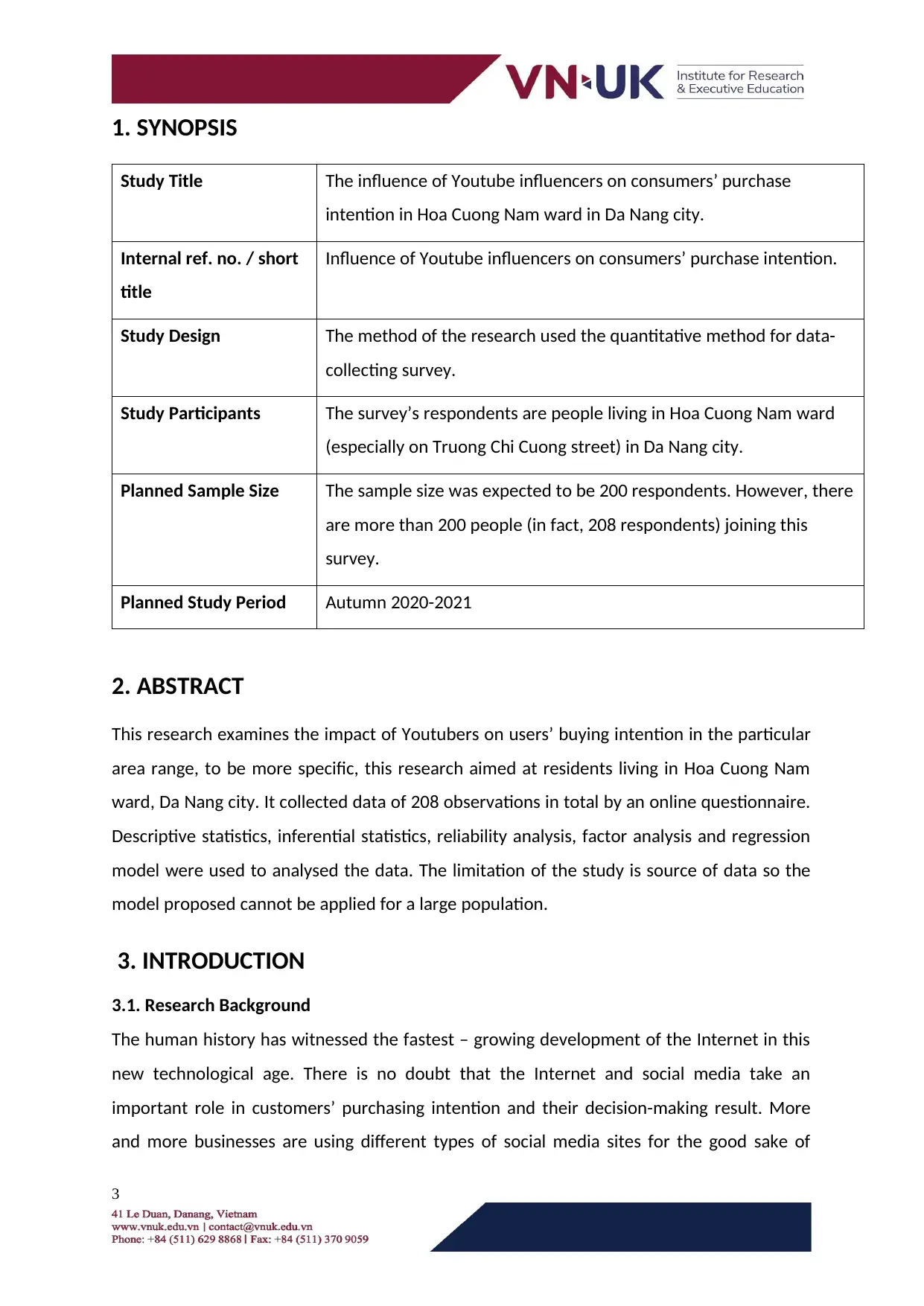
1. SYNOPSIS
Study Title The influence of Youtube influencers on consumers’ purchase
intention in Hoa Cuong Nam ward in Da Nang city.
Internal ref. no. / short
title
Influence of Youtube influencers on consumers’ purchase intention.
Study Design The method of the research used the quantitative method for data-
collecting survey.
Study Participants The survey’s respondents are people living in Hoa Cuong Nam ward
(especially on Truong Chi Cuong street) in Da Nang city.
Planned Sample Size The sample size was expected to be 200 respondents. However, there
are more than 200 people (in fact, 208 respondents) joining this
survey.
Planned Study Period Autumn 2020-2021
2. ABSTRACT
This research examines the impact of Youtubers on users’ buying intention in the particular
area range, to be more specific, this research aimed at residents living in Hoa Cuong Nam
ward, Da Nang city. It collected data of 208 observations in total by an online questionnaire.
Descriptive statistics, inferential statistics, reliability analysis, factor analysis and regression
model were used to analysed the data. The limitation of the study is source of data so the
model proposed cannot be applied for a large population.
3. INTRODUCTION
3.1. Research Background
The human history has witnessed the fastest – growing development of the Internet in this
new technological age. There is no doubt that the Internet and social media take an
important role in customers’ purchasing intention and their decision-making result. More
and more businesses are using different types of social media sites for the good sake of
3
Study Title The influence of Youtube influencers on consumers’ purchase
intention in Hoa Cuong Nam ward in Da Nang city.
Internal ref. no. / short
title
Influence of Youtube influencers on consumers’ purchase intention.
Study Design The method of the research used the quantitative method for data-
collecting survey.
Study Participants The survey’s respondents are people living in Hoa Cuong Nam ward
(especially on Truong Chi Cuong street) in Da Nang city.
Planned Sample Size The sample size was expected to be 200 respondents. However, there
are more than 200 people (in fact, 208 respondents) joining this
survey.
Planned Study Period Autumn 2020-2021
2. ABSTRACT
This research examines the impact of Youtubers on users’ buying intention in the particular
area range, to be more specific, this research aimed at residents living in Hoa Cuong Nam
ward, Da Nang city. It collected data of 208 observations in total by an online questionnaire.
Descriptive statistics, inferential statistics, reliability analysis, factor analysis and regression
model were used to analysed the data. The limitation of the study is source of data so the
model proposed cannot be applied for a large population.
3. INTRODUCTION
3.1. Research Background
The human history has witnessed the fastest – growing development of the Internet in this
new technological age. There is no doubt that the Internet and social media take an
important role in customers’ purchasing intention and their decision-making result. More
and more businesses are using different types of social media sites for the good sake of
3
⊘ This is a preview!⊘
Do you want full access?
Subscribe today to unlock all pages.

Trusted by 1+ million students worldwide
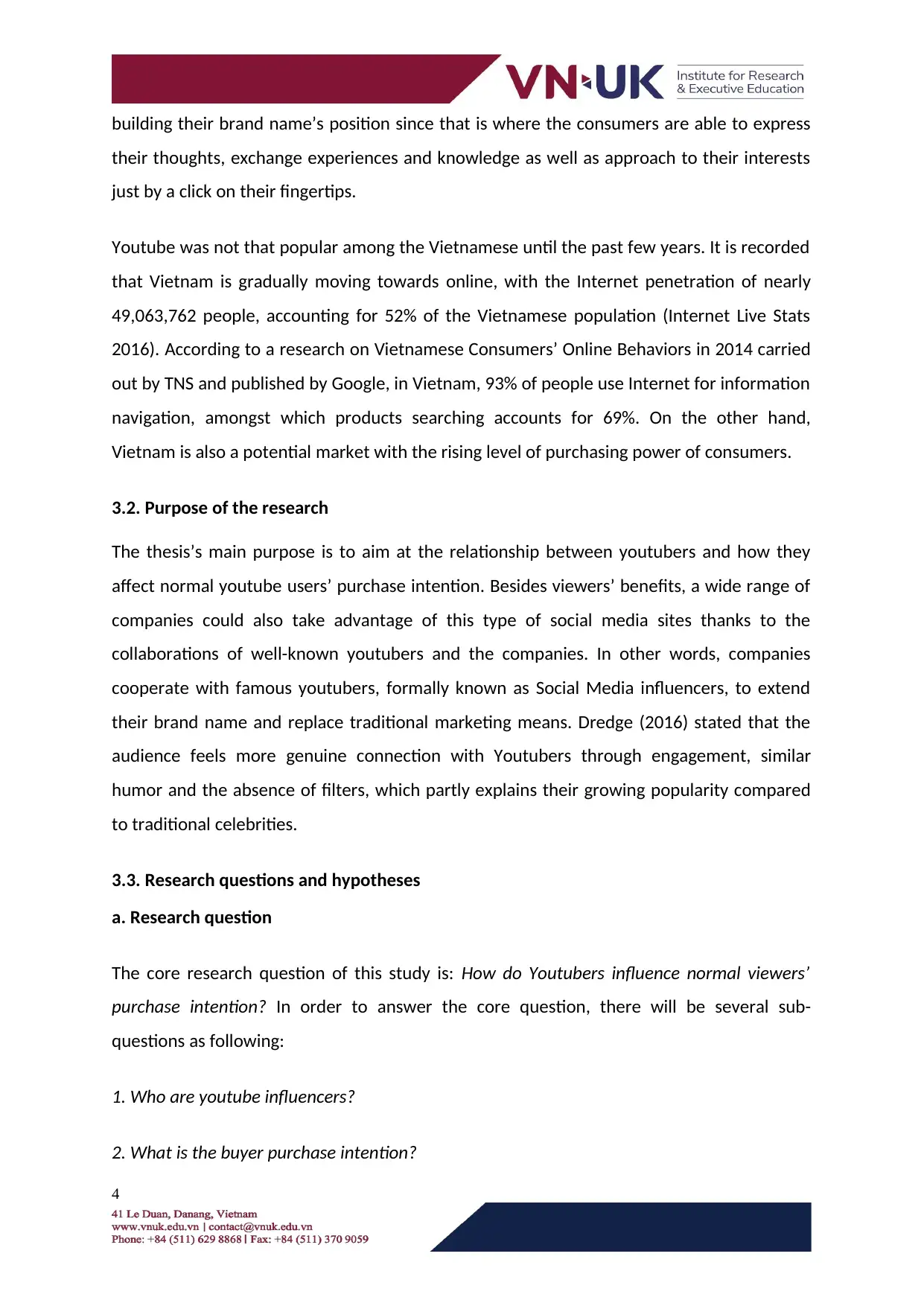
building their brand name’s position since that is where the consumers are able to express
their thoughts, exchange experiences and knowledge as well as approach to their interests
just by a click on their fingertips.
Youtube was not that popular among the Vietnamese until the past few years. It is recorded
that Vietnam is gradually moving towards online, with the Internet penetration of nearly
49,063,762 people, accounting for 52% of the Vietnamese population (Internet Live Stats
2016). According to a research on Vietnamese Consumers’ Online Behaviors in 2014 carried
out by TNS and published by Google, in Vietnam, 93% of people use Internet for information
navigation, amongst which products searching accounts for 69%. On the other hand,
Vietnam is also a potential market with the rising level of purchasing power of consumers.
3.2. Purpose of the research
The thesis’s main purpose is to aim at the relationship between youtubers and how they
affect normal youtube users’ purchase intention. Besides viewers’ benefits, a wide range of
companies could also take advantage of this type of social media sites thanks to the
collaborations of well-known youtubers and the companies. In other words, companies
cooperate with famous youtubers, formally known as Social Media influencers, to extend
their brand name and replace traditional marketing means. Dredge (2016) stated that the
audience feels more genuine connection with Youtubers through engagement, similar
humor and the absence of filters, which partly explains their growing popularity compared
to traditional celebrities.
3.3. Research questions and hypotheses
a. Research question
The core research question of this study is: How do Youtubers influence normal viewers’
purchase intention? In order to answer the core question, there will be several sub-
questions as following:
1. Who are youtube influencers?
2. What is the buyer purchase intention?
4
their thoughts, exchange experiences and knowledge as well as approach to their interests
just by a click on their fingertips.
Youtube was not that popular among the Vietnamese until the past few years. It is recorded
that Vietnam is gradually moving towards online, with the Internet penetration of nearly
49,063,762 people, accounting for 52% of the Vietnamese population (Internet Live Stats
2016). According to a research on Vietnamese Consumers’ Online Behaviors in 2014 carried
out by TNS and published by Google, in Vietnam, 93% of people use Internet for information
navigation, amongst which products searching accounts for 69%. On the other hand,
Vietnam is also a potential market with the rising level of purchasing power of consumers.
3.2. Purpose of the research
The thesis’s main purpose is to aim at the relationship between youtubers and how they
affect normal youtube users’ purchase intention. Besides viewers’ benefits, a wide range of
companies could also take advantage of this type of social media sites thanks to the
collaborations of well-known youtubers and the companies. In other words, companies
cooperate with famous youtubers, formally known as Social Media influencers, to extend
their brand name and replace traditional marketing means. Dredge (2016) stated that the
audience feels more genuine connection with Youtubers through engagement, similar
humor and the absence of filters, which partly explains their growing popularity compared
to traditional celebrities.
3.3. Research questions and hypotheses
a. Research question
The core research question of this study is: How do Youtubers influence normal viewers’
purchase intention? In order to answer the core question, there will be several sub-
questions as following:
1. Who are youtube influencers?
2. What is the buyer purchase intention?
4
Paraphrase This Document
Need a fresh take? Get an instant paraphrase of this document with our AI Paraphraser
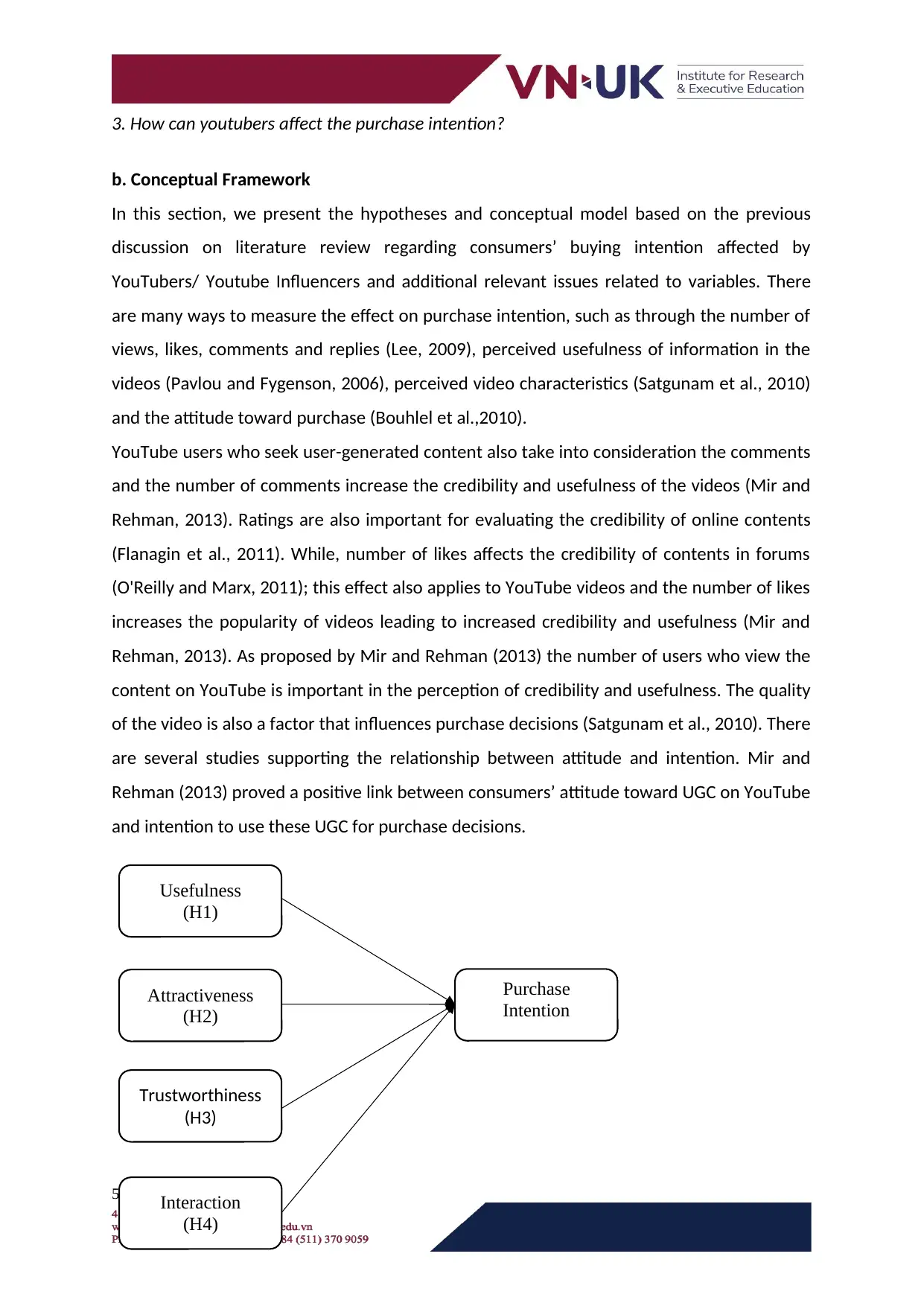
3. How can youtubers affect the purchase intention?
b. Conceptual Framework
In this section, we present the hypotheses and conceptual model based on the previous
discussion on literature review regarding consumers’ buying intention affected by
YouTubers/ Youtube Influencers and additional relevant issues related to variables. There
are many ways to measure the effect on purchase intention, such as through the number of
views, likes, comments and replies (Lee, 2009), perceived usefulness of information in the
videos (Pavlou and Fygenson, 2006), perceived video characteristics (Satgunam et al., 2010)
and the attitude toward purchase (Bouhlel et al.,2010).
YouTube users who seek user-generated content also take into consideration the comments
and the number of comments increase the credibility and usefulness of the videos (Mir and
Rehman, 2013). Ratings are also important for evaluating the credibility of online contents
(Flanagin et al., 2011). While, number of likes affects the credibility of contents in forums
(O'Reilly and Marx, 2011); this effect also applies to YouTube videos and the number of likes
increases the popularity of videos leading to increased credibility and usefulness (Mir and
Rehman, 2013). As proposed by Mir and Rehman (2013) the number of users who view the
content on YouTube is important in the perception of credibility and usefulness. The quality
of the video is also a factor that influences purchase decisions (Satgunam et al., 2010). There
are several studies supporting the relationship between attitude and intention. Mir and
Rehman (2013) proved a positive link between consumers’ attitude toward UGC on YouTube
and intention to use these UGC for purchase decisions.
5
Usefulness
(H1)
Attractiveness
(H2)
Trustworthiness
(H3)
Purchase
Intention
Interaction
(H4)
b. Conceptual Framework
In this section, we present the hypotheses and conceptual model based on the previous
discussion on literature review regarding consumers’ buying intention affected by
YouTubers/ Youtube Influencers and additional relevant issues related to variables. There
are many ways to measure the effect on purchase intention, such as through the number of
views, likes, comments and replies (Lee, 2009), perceived usefulness of information in the
videos (Pavlou and Fygenson, 2006), perceived video characteristics (Satgunam et al., 2010)
and the attitude toward purchase (Bouhlel et al.,2010).
YouTube users who seek user-generated content also take into consideration the comments
and the number of comments increase the credibility and usefulness of the videos (Mir and
Rehman, 2013). Ratings are also important for evaluating the credibility of online contents
(Flanagin et al., 2011). While, number of likes affects the credibility of contents in forums
(O'Reilly and Marx, 2011); this effect also applies to YouTube videos and the number of likes
increases the popularity of videos leading to increased credibility and usefulness (Mir and
Rehman, 2013). As proposed by Mir and Rehman (2013) the number of users who view the
content on YouTube is important in the perception of credibility and usefulness. The quality
of the video is also a factor that influences purchase decisions (Satgunam et al., 2010). There
are several studies supporting the relationship between attitude and intention. Mir and
Rehman (2013) proved a positive link between consumers’ attitude toward UGC on YouTube
and intention to use these UGC for purchase decisions.
5
Usefulness
(H1)
Attractiveness
(H2)
Trustworthiness
(H3)
Purchase
Intention
Interaction
(H4)
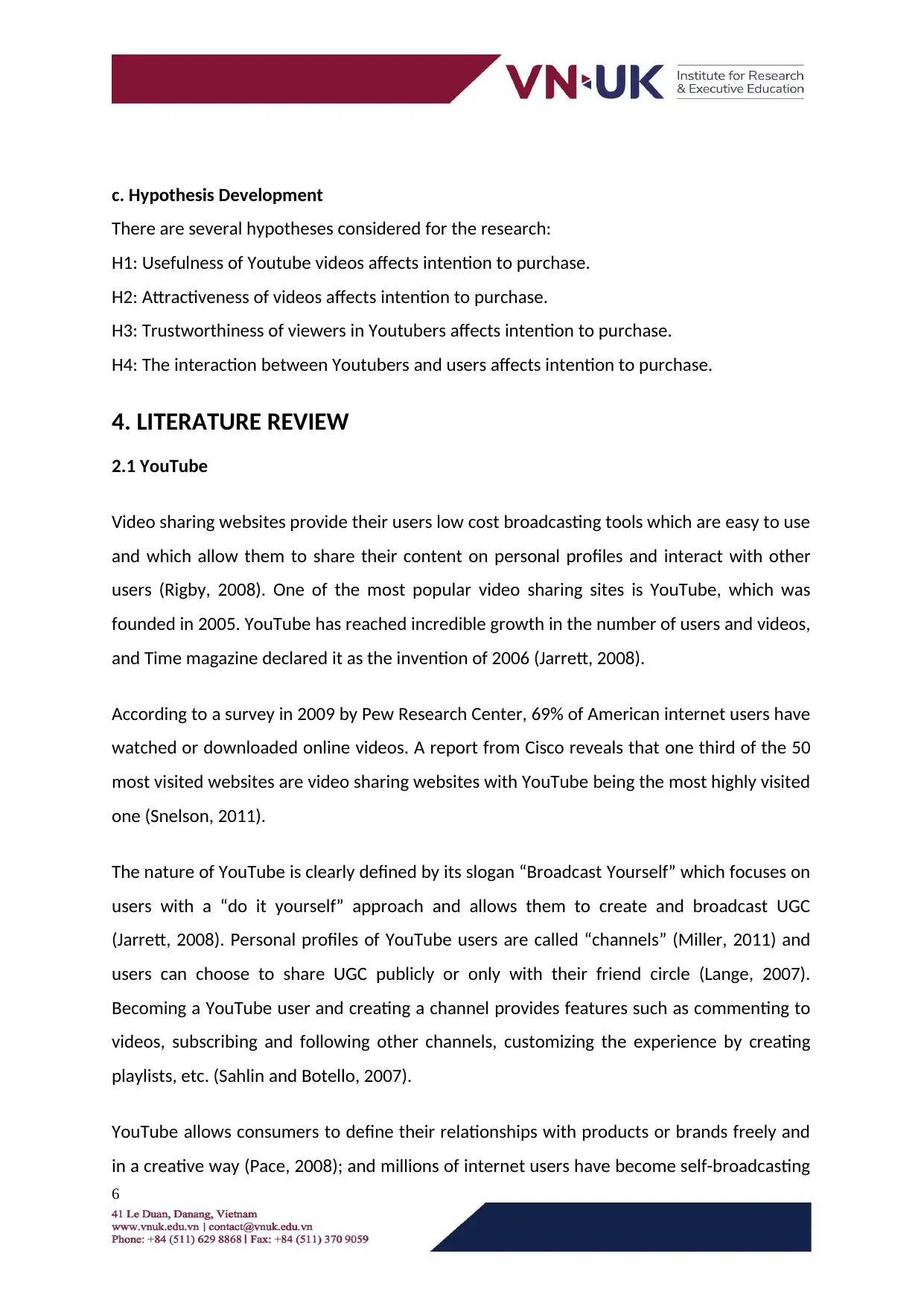
c. Hypothesis Development
There are several hypotheses considered for the research:
H1: Usefulness of Youtube videos affects intention to purchase.
H2: Attractiveness of videos affects intention to purchase.
H3: Trustworthiness of viewers in Youtubers affects intention to purchase.
H4: The interaction between Youtubers and users affects intention to purchase.
4. LITERATURE REVIEW
2.1 YouTube
Video sharing websites provide their users low cost broadcasting tools which are easy to use
and which allow them to share their content on personal profiles and interact with other
users (Rigby, 2008). One of the most popular video sharing sites is YouTube, which was
founded in 2005. YouTube has reached incredible growth in the number of users and videos,
and Time magazine declared it as the invention of 2006 (Jarrett, 2008).
According to a survey in 2009 by Pew Research Center, 69% of American internet users have
watched or downloaded online videos. A report from Cisco reveals that one third of the 50
most visited websites are video sharing websites with YouTube being the most highly visited
one (Snelson, 2011).
The nature of YouTube is clearly defined by its slogan “Broadcast Yourself” which focuses on
users with a “do it yourself” approach and allows them to create and broadcast UGC
(Jarrett, 2008). Personal profiles of YouTube users are called “channels” (Miller, 2011) and
users can choose to share UGC publicly or only with their friend circle (Lange, 2007).
Becoming a YouTube user and creating a channel provides features such as commenting to
videos, subscribing and following other channels, customizing the experience by creating
playlists, etc. (Sahlin and Botello, 2007).
YouTube allows consumers to define their relationships with products or brands freely and
in a creative way (Pace, 2008); and millions of internet users have become self-broadcasting
6
There are several hypotheses considered for the research:
H1: Usefulness of Youtube videos affects intention to purchase.
H2: Attractiveness of videos affects intention to purchase.
H3: Trustworthiness of viewers in Youtubers affects intention to purchase.
H4: The interaction between Youtubers and users affects intention to purchase.
4. LITERATURE REVIEW
2.1 YouTube
Video sharing websites provide their users low cost broadcasting tools which are easy to use
and which allow them to share their content on personal profiles and interact with other
users (Rigby, 2008). One of the most popular video sharing sites is YouTube, which was
founded in 2005. YouTube has reached incredible growth in the number of users and videos,
and Time magazine declared it as the invention of 2006 (Jarrett, 2008).
According to a survey in 2009 by Pew Research Center, 69% of American internet users have
watched or downloaded online videos. A report from Cisco reveals that one third of the 50
most visited websites are video sharing websites with YouTube being the most highly visited
one (Snelson, 2011).
The nature of YouTube is clearly defined by its slogan “Broadcast Yourself” which focuses on
users with a “do it yourself” approach and allows them to create and broadcast UGC
(Jarrett, 2008). Personal profiles of YouTube users are called “channels” (Miller, 2011) and
users can choose to share UGC publicly or only with their friend circle (Lange, 2007).
Becoming a YouTube user and creating a channel provides features such as commenting to
videos, subscribing and following other channels, customizing the experience by creating
playlists, etc. (Sahlin and Botello, 2007).
YouTube allows consumers to define their relationships with products or brands freely and
in a creative way (Pace, 2008); and millions of internet users have become self-broadcasting
6
⊘ This is a preview!⊘
Do you want full access?
Subscribe today to unlock all pages.

Trusted by 1+ million students worldwide
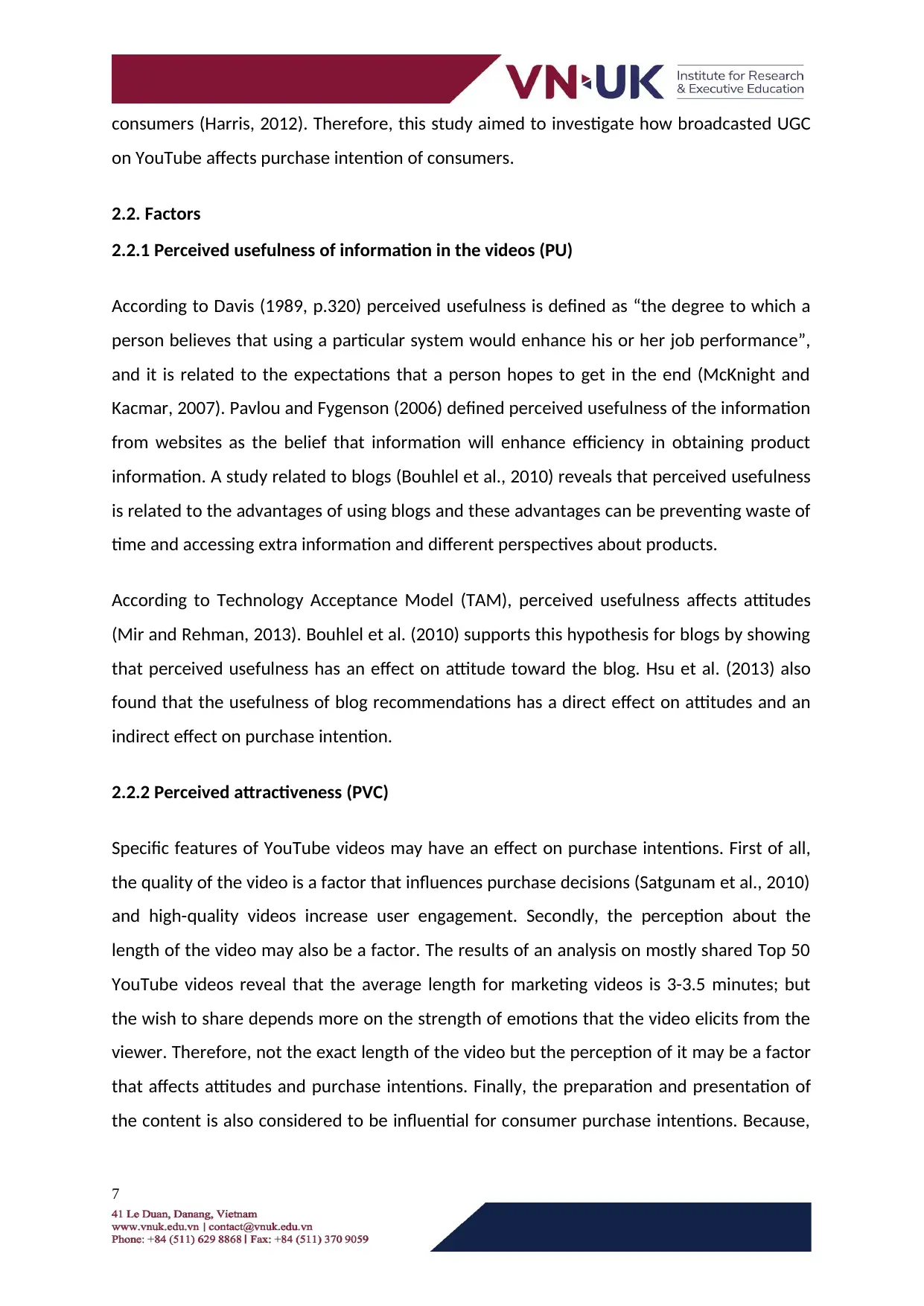
consumers (Harris, 2012). Therefore, this study aimed to investigate how broadcasted UGC
on YouTube affects purchase intention of consumers.
2.2. Factors
2.2.1 Perceived usefulness of information in the videos (PU)
According to Davis (1989, p.320) perceived usefulness is defined as “the degree to which a
person believes that using a particular system would enhance his or her job performance”,
and it is related to the expectations that a person hopes to get in the end (McKnight and
Kacmar, 2007). Pavlou and Fygenson (2006) defined perceived usefulness of the information
from websites as the belief that information will enhance efficiency in obtaining product
information. A study related to blogs (Bouhlel et al., 2010) reveals that perceived usefulness
is related to the advantages of using blogs and these advantages can be preventing waste of
time and accessing extra information and different perspectives about products.
According to Technology Acceptance Model (TAM), perceived usefulness affects attitudes
(Mir and Rehman, 2013). Bouhlel et al. (2010) supports this hypothesis for blogs by showing
that perceived usefulness has an effect on attitude toward the blog. Hsu et al. (2013) also
found that the usefulness of blog recommendations has a direct effect on attitudes and an
indirect effect on purchase intention.
2.2.2 Perceived attractiveness (PVC)
Specific features of YouTube videos may have an effect on purchase intentions. First of all,
the quality of the video is a factor that influences purchase decisions (Satgunam et al., 2010)
and high-quality videos increase user engagement. Secondly, the perception about the
length of the video may also be a factor. The results of an analysis on mostly shared Top 50
YouTube videos reveal that the average length for marketing videos is 3-3.5 minutes; but
the wish to share depends more on the strength of emotions that the video elicits from the
viewer. Therefore, not the exact length of the video but the perception of it may be a factor
that affects attitudes and purchase intentions. Finally, the preparation and presentation of
the content is also considered to be influential for consumer purchase intentions. Because,
7
on YouTube affects purchase intention of consumers.
2.2. Factors
2.2.1 Perceived usefulness of information in the videos (PU)
According to Davis (1989, p.320) perceived usefulness is defined as “the degree to which a
person believes that using a particular system would enhance his or her job performance”,
and it is related to the expectations that a person hopes to get in the end (McKnight and
Kacmar, 2007). Pavlou and Fygenson (2006) defined perceived usefulness of the information
from websites as the belief that information will enhance efficiency in obtaining product
information. A study related to blogs (Bouhlel et al., 2010) reveals that perceived usefulness
is related to the advantages of using blogs and these advantages can be preventing waste of
time and accessing extra information and different perspectives about products.
According to Technology Acceptance Model (TAM), perceived usefulness affects attitudes
(Mir and Rehman, 2013). Bouhlel et al. (2010) supports this hypothesis for blogs by showing
that perceived usefulness has an effect on attitude toward the blog. Hsu et al. (2013) also
found that the usefulness of blog recommendations has a direct effect on attitudes and an
indirect effect on purchase intention.
2.2.2 Perceived attractiveness (PVC)
Specific features of YouTube videos may have an effect on purchase intentions. First of all,
the quality of the video is a factor that influences purchase decisions (Satgunam et al., 2010)
and high-quality videos increase user engagement. Secondly, the perception about the
length of the video may also be a factor. The results of an analysis on mostly shared Top 50
YouTube videos reveal that the average length for marketing videos is 3-3.5 minutes; but
the wish to share depends more on the strength of emotions that the video elicits from the
viewer. Therefore, not the exact length of the video but the perception of it may be a factor
that affects attitudes and purchase intentions. Finally, the preparation and presentation of
the content is also considered to be influential for consumer purchase intentions. Because,
7
Paraphrase This Document
Need a fresh take? Get an instant paraphrase of this document with our AI Paraphraser
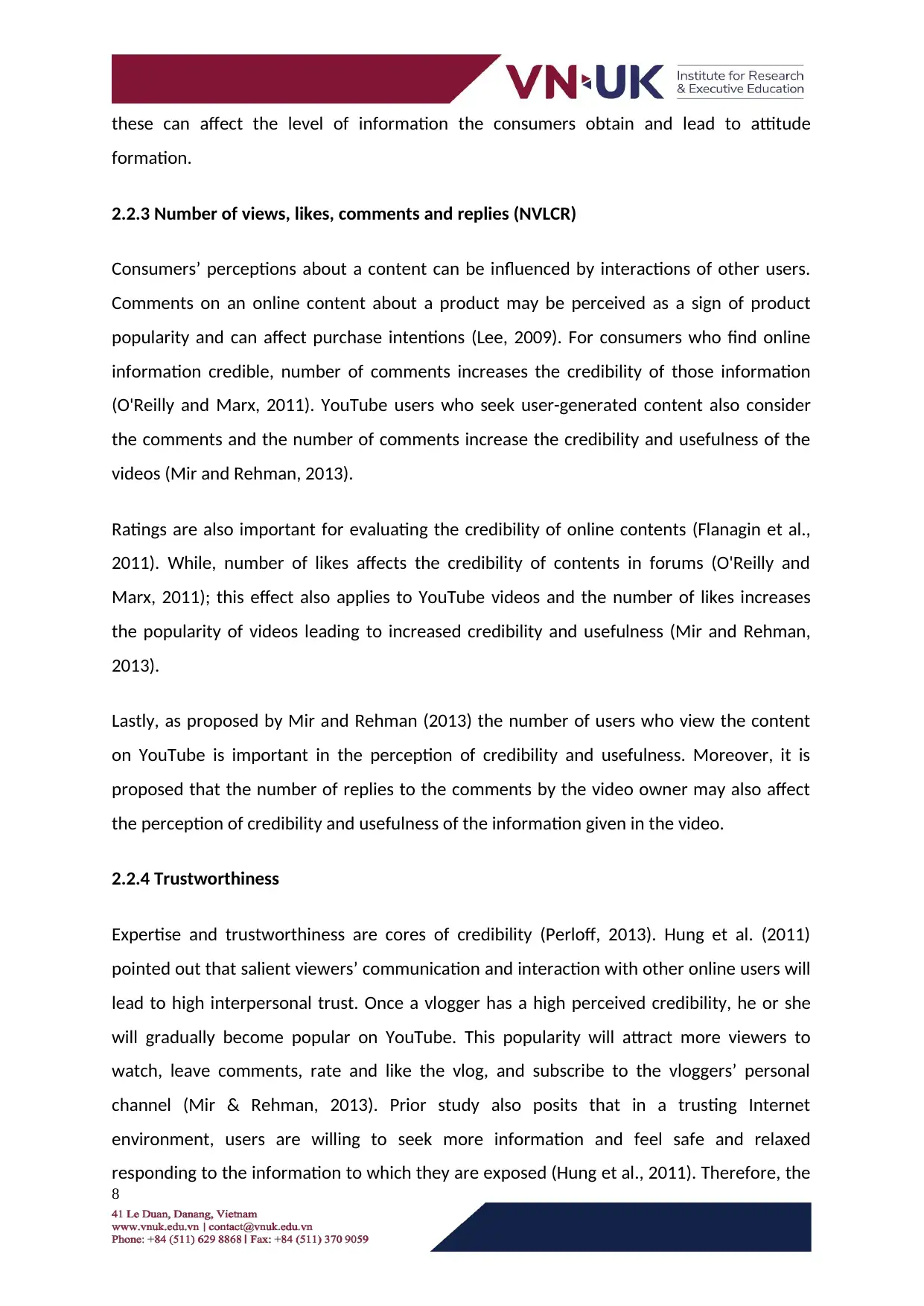
these can affect the level of information the consumers obtain and lead to attitude
formation.
2.2.3 Number of views, likes, comments and replies (NVLCR)
Consumers’ perceptions about a content can be influenced by interactions of other users.
Comments on an online content about a product may be perceived as a sign of product
popularity and can affect purchase intentions (Lee, 2009). For consumers who find online
information credible, number of comments increases the credibility of those information
(O'Reilly and Marx, 2011). YouTube users who seek user-generated content also consider
the comments and the number of comments increase the credibility and usefulness of the
videos (Mir and Rehman, 2013).
Ratings are also important for evaluating the credibility of online contents (Flanagin et al.,
2011). While, number of likes affects the credibility of contents in forums (O'Reilly and
Marx, 2011); this effect also applies to YouTube videos and the number of likes increases
the popularity of videos leading to increased credibility and usefulness (Mir and Rehman,
2013).
Lastly, as proposed by Mir and Rehman (2013) the number of users who view the content
on YouTube is important in the perception of credibility and usefulness. Moreover, it is
proposed that the number of replies to the comments by the video owner may also affect
the perception of credibility and usefulness of the information given in the video.
2.2.4 Trustworthiness
Expertise and trustworthiness are cores of credibility (Perloff, 2013). Hung et al. (2011)
pointed out that salient viewers’ communication and interaction with other online users will
lead to high interpersonal trust. Once a vlogger has a high perceived credibility, he or she
will gradually become popular on YouTube. This popularity will attract more viewers to
watch, leave comments, rate and like the vlog, and subscribe to the vloggers’ personal
channel (Mir & Rehman, 2013). Prior study also posits that in a trusting Internet
environment, users are willing to seek more information and feel safe and relaxed
responding to the information to which they are exposed (Hung et al., 2011). Therefore, the
8
formation.
2.2.3 Number of views, likes, comments and replies (NVLCR)
Consumers’ perceptions about a content can be influenced by interactions of other users.
Comments on an online content about a product may be perceived as a sign of product
popularity and can affect purchase intentions (Lee, 2009). For consumers who find online
information credible, number of comments increases the credibility of those information
(O'Reilly and Marx, 2011). YouTube users who seek user-generated content also consider
the comments and the number of comments increase the credibility and usefulness of the
videos (Mir and Rehman, 2013).
Ratings are also important for evaluating the credibility of online contents (Flanagin et al.,
2011). While, number of likes affects the credibility of contents in forums (O'Reilly and
Marx, 2011); this effect also applies to YouTube videos and the number of likes increases
the popularity of videos leading to increased credibility and usefulness (Mir and Rehman,
2013).
Lastly, as proposed by Mir and Rehman (2013) the number of users who view the content
on YouTube is important in the perception of credibility and usefulness. Moreover, it is
proposed that the number of replies to the comments by the video owner may also affect
the perception of credibility and usefulness of the information given in the video.
2.2.4 Trustworthiness
Expertise and trustworthiness are cores of credibility (Perloff, 2013). Hung et al. (2011)
pointed out that salient viewers’ communication and interaction with other online users will
lead to high interpersonal trust. Once a vlogger has a high perceived credibility, he or she
will gradually become popular on YouTube. This popularity will attract more viewers to
watch, leave comments, rate and like the vlog, and subscribe to the vloggers’ personal
channel (Mir & Rehman, 2013). Prior study also posits that in a trusting Internet
environment, users are willing to seek more information and feel safe and relaxed
responding to the information to which they are exposed (Hung et al., 2011). Therefore, the
8
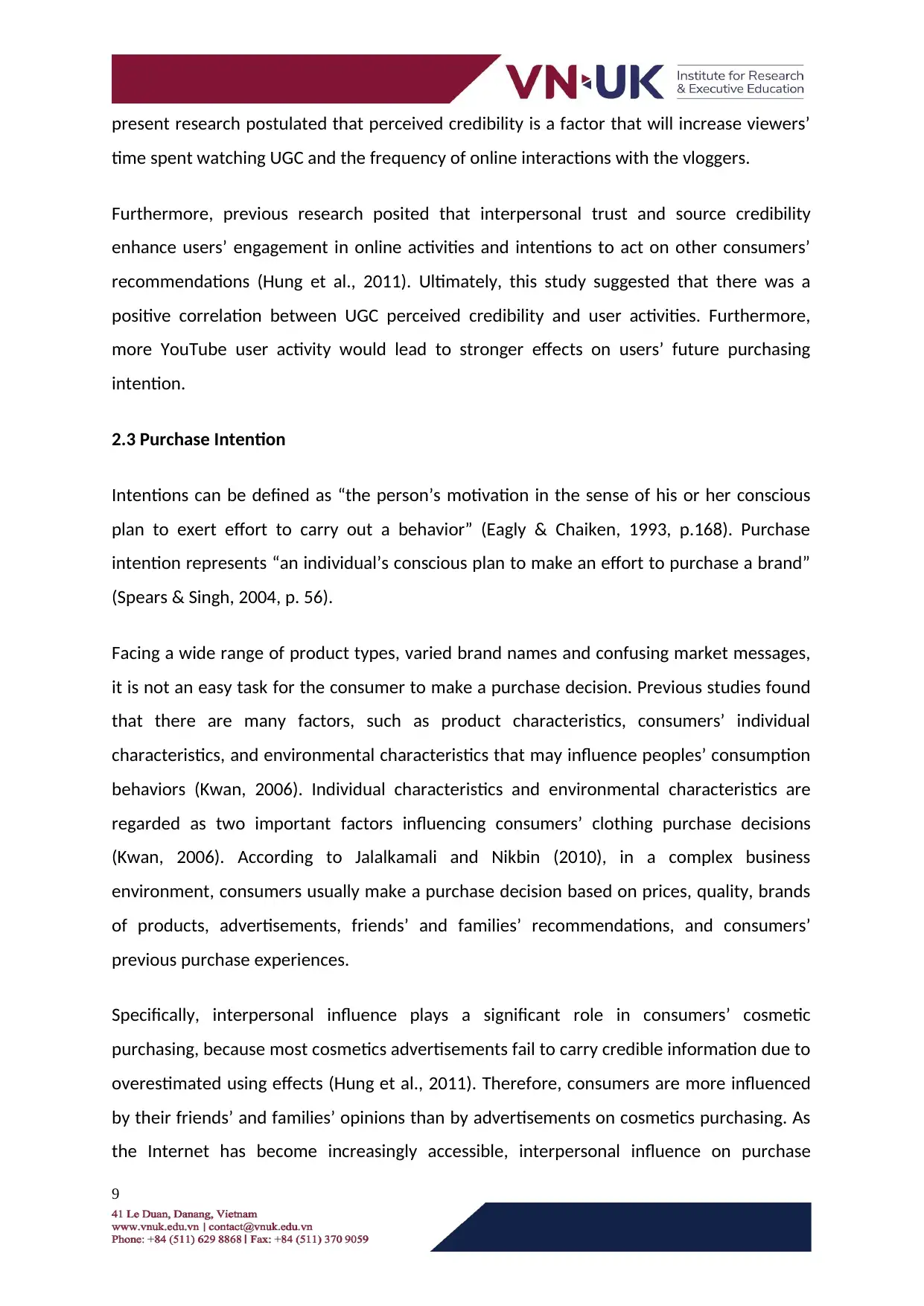
present research postulated that perceived credibility is a factor that will increase viewers’
time spent watching UGC and the frequency of online interactions with the vloggers.
Furthermore, previous research posited that interpersonal trust and source credibility
enhance users’ engagement in online activities and intentions to act on other consumers’
recommendations (Hung et al., 2011). Ultimately, this study suggested that there was a
positive correlation between UGC perceived credibility and user activities. Furthermore,
more YouTube user activity would lead to stronger effects on users’ future purchasing
intention.
2.3 Purchase Intention
Intentions can be defined as “the person’s motivation in the sense of his or her conscious
plan to exert effort to carry out a behavior” (Eagly & Chaiken, 1993, p.168). Purchase
intention represents “an individual’s conscious plan to make an effort to purchase a brand”
(Spears & Singh, 2004, p. 56).
Facing a wide range of product types, varied brand names and confusing market messages,
it is not an easy task for the consumer to make a purchase decision. Previous studies found
that there are many factors, such as product characteristics, consumers’ individual
characteristics, and environmental characteristics that may influence peoples’ consumption
behaviors (Kwan, 2006). Individual characteristics and environmental characteristics are
regarded as two important factors influencing consumers’ clothing purchase decisions
(Kwan, 2006). According to Jalalkamali and Nikbin (2010), in a complex business
environment, consumers usually make a purchase decision based on prices, quality, brands
of products, advertisements, friends’ and families’ recommendations, and consumers’
previous purchase experiences.
Specifically, interpersonal influence plays a significant role in consumers’ cosmetic
purchasing, because most cosmetics advertisements fail to carry credible information due to
overestimated using effects (Hung et al., 2011). Therefore, consumers are more influenced
by their friends’ and families’ opinions than by advertisements on cosmetics purchasing. As
the Internet has become increasingly accessible, interpersonal influence on purchase
9
time spent watching UGC and the frequency of online interactions with the vloggers.
Furthermore, previous research posited that interpersonal trust and source credibility
enhance users’ engagement in online activities and intentions to act on other consumers’
recommendations (Hung et al., 2011). Ultimately, this study suggested that there was a
positive correlation between UGC perceived credibility and user activities. Furthermore,
more YouTube user activity would lead to stronger effects on users’ future purchasing
intention.
2.3 Purchase Intention
Intentions can be defined as “the person’s motivation in the sense of his or her conscious
plan to exert effort to carry out a behavior” (Eagly & Chaiken, 1993, p.168). Purchase
intention represents “an individual’s conscious plan to make an effort to purchase a brand”
(Spears & Singh, 2004, p. 56).
Facing a wide range of product types, varied brand names and confusing market messages,
it is not an easy task for the consumer to make a purchase decision. Previous studies found
that there are many factors, such as product characteristics, consumers’ individual
characteristics, and environmental characteristics that may influence peoples’ consumption
behaviors (Kwan, 2006). Individual characteristics and environmental characteristics are
regarded as two important factors influencing consumers’ clothing purchase decisions
(Kwan, 2006). According to Jalalkamali and Nikbin (2010), in a complex business
environment, consumers usually make a purchase decision based on prices, quality, brands
of products, advertisements, friends’ and families’ recommendations, and consumers’
previous purchase experiences.
Specifically, interpersonal influence plays a significant role in consumers’ cosmetic
purchasing, because most cosmetics advertisements fail to carry credible information due to
overestimated using effects (Hung et al., 2011). Therefore, consumers are more influenced
by their friends’ and families’ opinions than by advertisements on cosmetics purchasing. As
the Internet has become increasingly accessible, interpersonal influence on purchase
9
⊘ This is a preview!⊘
Do you want full access?
Subscribe today to unlock all pages.

Trusted by 1+ million students worldwide
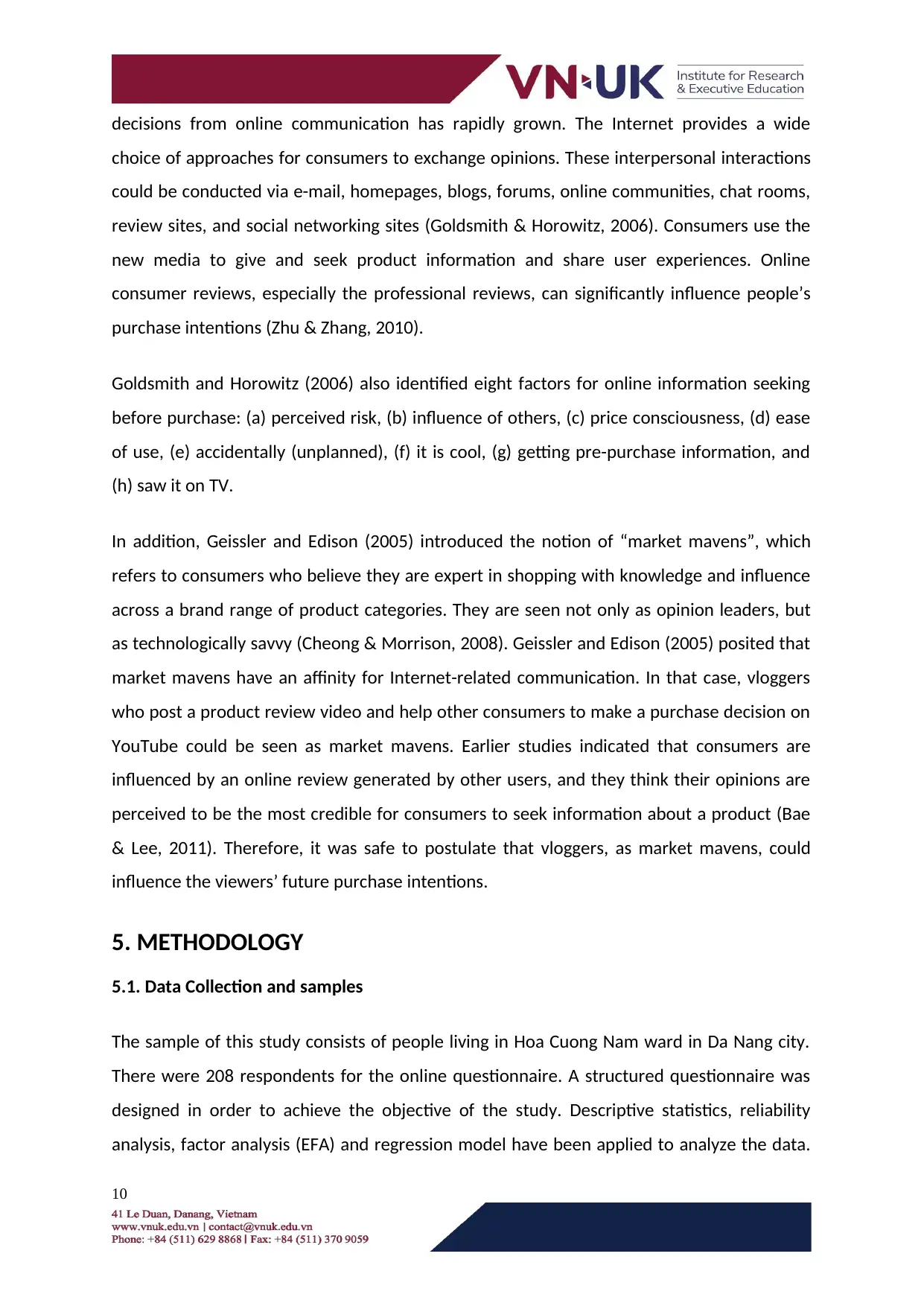
decisions from online communication has rapidly grown. The Internet provides a wide
choice of approaches for consumers to exchange opinions. These interpersonal interactions
could be conducted via e-mail, homepages, blogs, forums, online communities, chat rooms,
review sites, and social networking sites (Goldsmith & Horowitz, 2006). Consumers use the
new media to give and seek product information and share user experiences. Online
consumer reviews, especially the professional reviews, can significantly influence people’s
purchase intentions (Zhu & Zhang, 2010).
Goldsmith and Horowitz (2006) also identified eight factors for online information seeking
before purchase: (a) perceived risk, (b) influence of others, (c) price consciousness, (d) ease
of use, (e) accidentally (unplanned), (f) it is cool, (g) getting pre-purchase information, and
(h) saw it on TV.
In addition, Geissler and Edison (2005) introduced the notion of “market mavens”, which
refers to consumers who believe they are expert in shopping with knowledge and influence
across a brand range of product categories. They are seen not only as opinion leaders, but
as technologically savvy (Cheong & Morrison, 2008). Geissler and Edison (2005) posited that
market mavens have an affinity for Internet-related communication. In that case, vloggers
who post a product review video and help other consumers to make a purchase decision on
YouTube could be seen as market mavens. Earlier studies indicated that consumers are
influenced by an online review generated by other users, and they think their opinions are
perceived to be the most credible for consumers to seek information about a product (Bae
& Lee, 2011). Therefore, it was safe to postulate that vloggers, as market mavens, could
influence the viewers’ future purchase intentions.
5. METHODOLOGY
5.1. Data Collection and samples
The sample of this study consists of people living in Hoa Cuong Nam ward in Da Nang city.
There were 208 respondents for the online questionnaire. A structured questionnaire was
designed in order to achieve the objective of the study. Descriptive statistics, reliability
analysis, factor analysis (EFA) and regression model have been applied to analyze the data.
10
choice of approaches for consumers to exchange opinions. These interpersonal interactions
could be conducted via e-mail, homepages, blogs, forums, online communities, chat rooms,
review sites, and social networking sites (Goldsmith & Horowitz, 2006). Consumers use the
new media to give and seek product information and share user experiences. Online
consumer reviews, especially the professional reviews, can significantly influence people’s
purchase intentions (Zhu & Zhang, 2010).
Goldsmith and Horowitz (2006) also identified eight factors for online information seeking
before purchase: (a) perceived risk, (b) influence of others, (c) price consciousness, (d) ease
of use, (e) accidentally (unplanned), (f) it is cool, (g) getting pre-purchase information, and
(h) saw it on TV.
In addition, Geissler and Edison (2005) introduced the notion of “market mavens”, which
refers to consumers who believe they are expert in shopping with knowledge and influence
across a brand range of product categories. They are seen not only as opinion leaders, but
as technologically savvy (Cheong & Morrison, 2008). Geissler and Edison (2005) posited that
market mavens have an affinity for Internet-related communication. In that case, vloggers
who post a product review video and help other consumers to make a purchase decision on
YouTube could be seen as market mavens. Earlier studies indicated that consumers are
influenced by an online review generated by other users, and they think their opinions are
perceived to be the most credible for consumers to seek information about a product (Bae
& Lee, 2011). Therefore, it was safe to postulate that vloggers, as market mavens, could
influence the viewers’ future purchase intentions.
5. METHODOLOGY
5.1. Data Collection and samples
The sample of this study consists of people living in Hoa Cuong Nam ward in Da Nang city.
There were 208 respondents for the online questionnaire. A structured questionnaire was
designed in order to achieve the objective of the study. Descriptive statistics, reliability
analysis, factor analysis (EFA) and regression model have been applied to analyze the data.
10
Paraphrase This Document
Need a fresh take? Get an instant paraphrase of this document with our AI Paraphraser
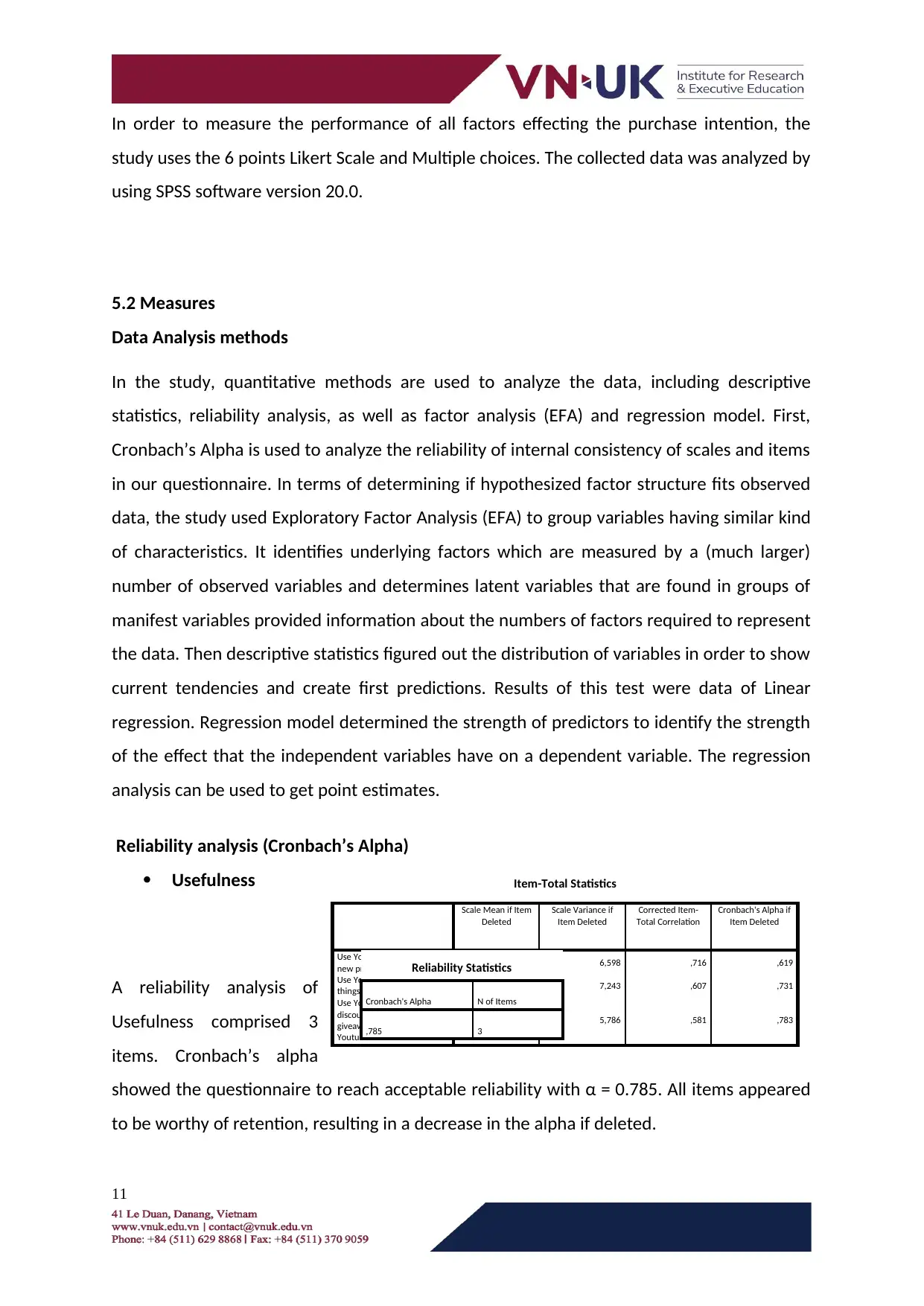
In order to measure the performance of all factors effecting the purchase intention, the
study uses the 6 points Likert Scale and Multiple choices. The collected data was analyzed by
using SPSS software version 20.0.
5.2 Measures
Data Analysis methods
In the study, quantitative methods are used to analyze the data, including descriptive
statistics, reliability analysis, as well as factor analysis (EFA) and regression model. First,
Cronbach’s Alpha is used to analyze the reliability of internal consistency of scales and items
in our questionnaire. In terms of determining if hypothesized factor structure fits observed
data, the study used Exploratory Factor Analysis (EFA) to group variables having similar kind
of characteristics. It identifies underlying factors which are measured by a (much larger)
number of observed variables and determines latent variables that are found in groups of
manifest variables provided information about the numbers of factors required to represent
the data. Then descriptive statistics figured out the distribution of variables in order to show
current tendencies and create first predictions. Results of this test were data of Linear
regression. Regression model determined the strength of predictors to identify the strength
of the effect that the independent variables have on a dependent variable. The regression
analysis can be used to get point estimates.
Reliability analysis (Cronbach’s Alpha)
Usefulness
A reliability analysis of
Usefulness comprised 3
items. Cronbach’s alpha
showed the questionnaire to reach acceptable reliability with α = 0.785. All items appeared
to be worthy of retention, resulting in a decrease in the alpha if deleted.
11
Item-Total Statistics
Scale Mean if Item
Deleted
Scale Variance if
Item Deleted
Corrected Item-
Total Correlation
Cronbach's Alpha if
Item Deleted
Use Youtube to search for
new products/ services 7,56 6,598 ,716 ,619
Use Youtube to search for
things that are aware of 7,28 7,243 ,607 ,731
Use Youtube to find
discounts/ promotions/
giveaways offered by
Youtubers.
8,46 5,786 ,581 ,783
Reliability Statistics
Cronbach's Alpha N of Items
,785 3
study uses the 6 points Likert Scale and Multiple choices. The collected data was analyzed by
using SPSS software version 20.0.
5.2 Measures
Data Analysis methods
In the study, quantitative methods are used to analyze the data, including descriptive
statistics, reliability analysis, as well as factor analysis (EFA) and regression model. First,
Cronbach’s Alpha is used to analyze the reliability of internal consistency of scales and items
in our questionnaire. In terms of determining if hypothesized factor structure fits observed
data, the study used Exploratory Factor Analysis (EFA) to group variables having similar kind
of characteristics. It identifies underlying factors which are measured by a (much larger)
number of observed variables and determines latent variables that are found in groups of
manifest variables provided information about the numbers of factors required to represent
the data. Then descriptive statistics figured out the distribution of variables in order to show
current tendencies and create first predictions. Results of this test were data of Linear
regression. Regression model determined the strength of predictors to identify the strength
of the effect that the independent variables have on a dependent variable. The regression
analysis can be used to get point estimates.
Reliability analysis (Cronbach’s Alpha)
Usefulness
A reliability analysis of
Usefulness comprised 3
items. Cronbach’s alpha
showed the questionnaire to reach acceptable reliability with α = 0.785. All items appeared
to be worthy of retention, resulting in a decrease in the alpha if deleted.
11
Item-Total Statistics
Scale Mean if Item
Deleted
Scale Variance if
Item Deleted
Corrected Item-
Total Correlation
Cronbach's Alpha if
Item Deleted
Use Youtube to search for
new products/ services 7,56 6,598 ,716 ,619
Use Youtube to search for
things that are aware of 7,28 7,243 ,607 ,731
Use Youtube to find
discounts/ promotions/
giveaways offered by
Youtubers.
8,46 5,786 ,581 ,783
Reliability Statistics
Cronbach's Alpha N of Items
,785 3
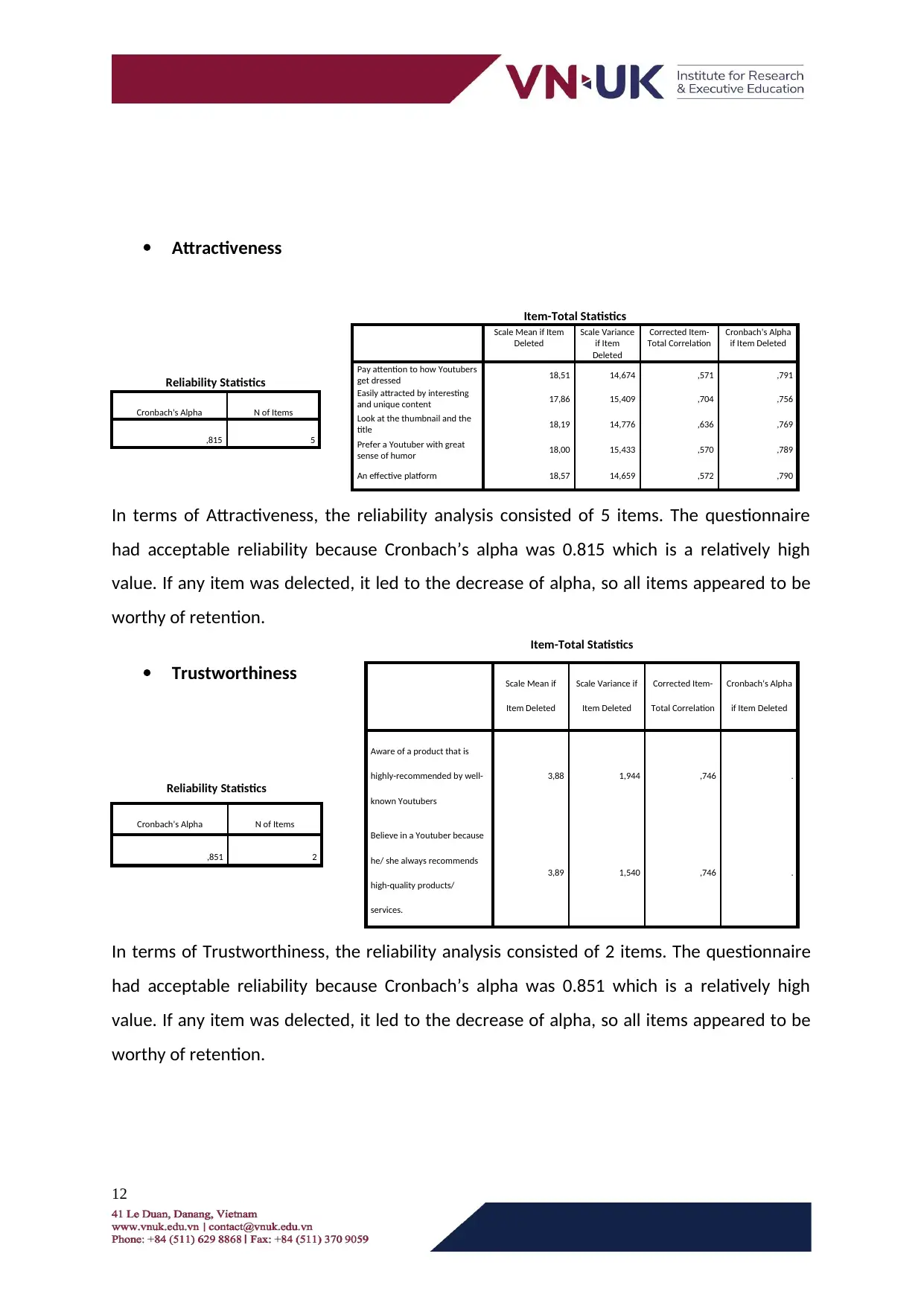
Attractiveness
In terms of Attractiveness, the reliability analysis consisted of 5 items. The questionnaire
had acceptable reliability because Cronbach’s alpha was 0.815 which is a relatively high
value. If any item was delected, it led to the decrease of alpha, so all items appeared to be
worthy of retention.
Trustworthiness
In terms of Trustworthiness, the reliability analysis consisted of 2 items. The questionnaire
had acceptable reliability because Cronbach’s alpha was 0.851 which is a relatively high
value. If any item was delected, it led to the decrease of alpha, so all items appeared to be
worthy of retention.
12
Item-Total Statistics
Scale Mean if Item
Deleted
Scale Variance
if Item
Deleted
Corrected Item-
Total Correlation
Cronbach's Alpha
if Item Deleted
Pay attention to how Youtubers
get dressed 18,51 14,674 ,571 ,791
Easily attracted by interesting
and unique content 17,86 15,409 ,704 ,756
Look at the thumbnail and the
title 18,19 14,776 ,636 ,769
Prefer a Youtuber with great
sense of humor 18,00 15,433 ,570 ,789
An effective platform 18,57 14,659 ,572 ,790
Reliability Statistics
Cronbach's Alpha N of Items
,815 5
Item-Total Statistics
Scale Mean if
Item Deleted
Scale Variance if
Item Deleted
Corrected Item-
Total Correlation
Cronbach's Alpha
if Item Deleted
Aware of a product that is
highly-recommended by well-
known Youtubers
3,88 1,944 ,746 .
Believe in a Youtuber because
he/ she always recommends
high-quality products/
services.
3,89 1,540 ,746 .
Reliability Statistics
Cronbach's Alpha N of Items
,851 2
In terms of Attractiveness, the reliability analysis consisted of 5 items. The questionnaire
had acceptable reliability because Cronbach’s alpha was 0.815 which is a relatively high
value. If any item was delected, it led to the decrease of alpha, so all items appeared to be
worthy of retention.
Trustworthiness
In terms of Trustworthiness, the reliability analysis consisted of 2 items. The questionnaire
had acceptable reliability because Cronbach’s alpha was 0.851 which is a relatively high
value. If any item was delected, it led to the decrease of alpha, so all items appeared to be
worthy of retention.
12
Item-Total Statistics
Scale Mean if Item
Deleted
Scale Variance
if Item
Deleted
Corrected Item-
Total Correlation
Cronbach's Alpha
if Item Deleted
Pay attention to how Youtubers
get dressed 18,51 14,674 ,571 ,791
Easily attracted by interesting
and unique content 17,86 15,409 ,704 ,756
Look at the thumbnail and the
title 18,19 14,776 ,636 ,769
Prefer a Youtuber with great
sense of humor 18,00 15,433 ,570 ,789
An effective platform 18,57 14,659 ,572 ,790
Reliability Statistics
Cronbach's Alpha N of Items
,815 5
Item-Total Statistics
Scale Mean if
Item Deleted
Scale Variance if
Item Deleted
Corrected Item-
Total Correlation
Cronbach's Alpha
if Item Deleted
Aware of a product that is
highly-recommended by well-
known Youtubers
3,88 1,944 ,746 .
Believe in a Youtuber because
he/ she always recommends
high-quality products/
services.
3,89 1,540 ,746 .
Reliability Statistics
Cronbach's Alpha N of Items
,851 2
⊘ This is a preview!⊘
Do you want full access?
Subscribe today to unlock all pages.

Trusted by 1+ million students worldwide
1 out of 30
Your All-in-One AI-Powered Toolkit for Academic Success.
+13062052269
info@desklib.com
Available 24*7 on WhatsApp / Email
![[object Object]](/_next/static/media/star-bottom.7253800d.svg)
Unlock your academic potential
Copyright © 2020–2025 A2Z Services. All Rights Reserved. Developed and managed by ZUCOL.

